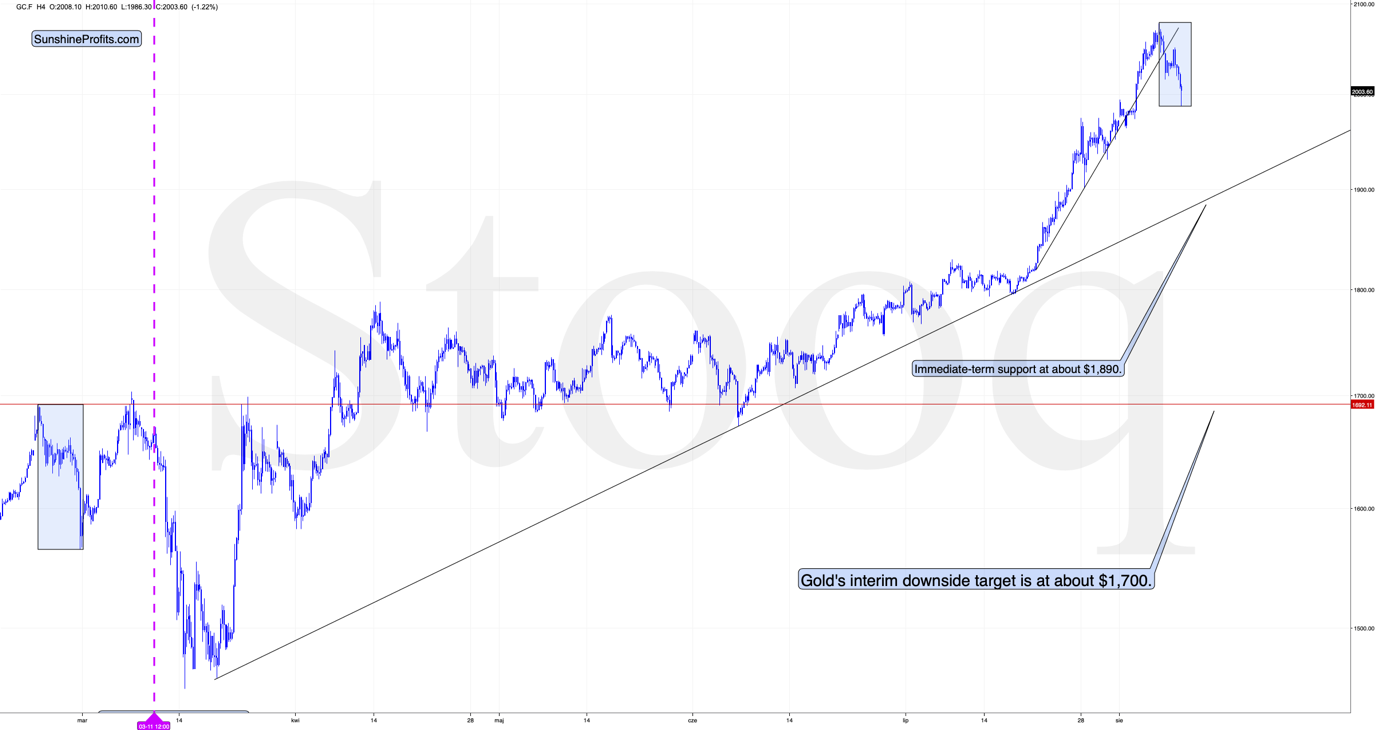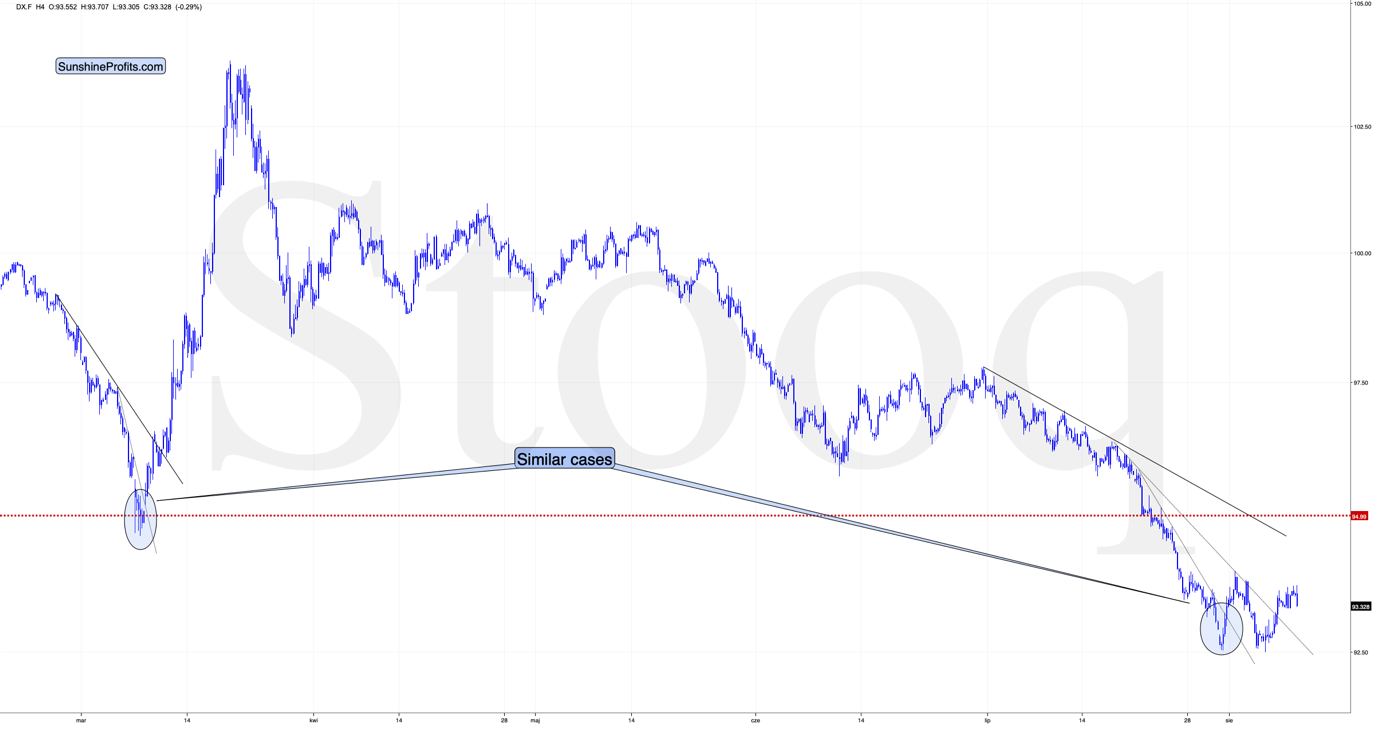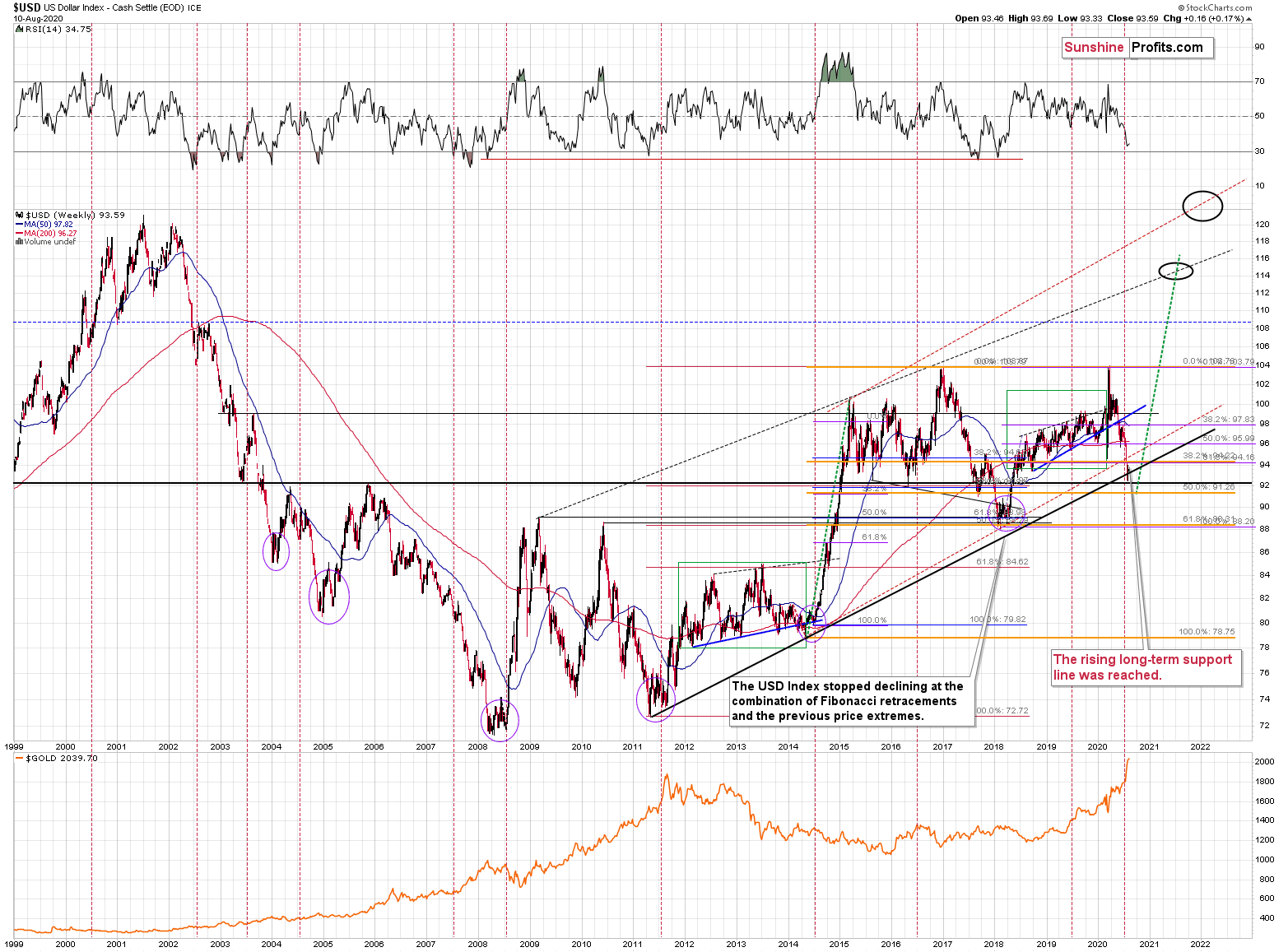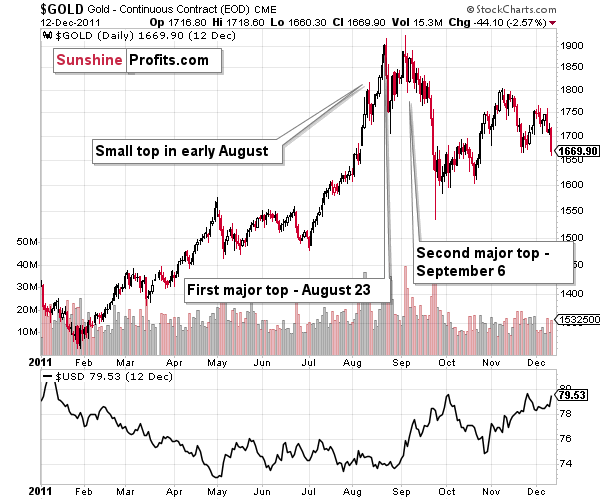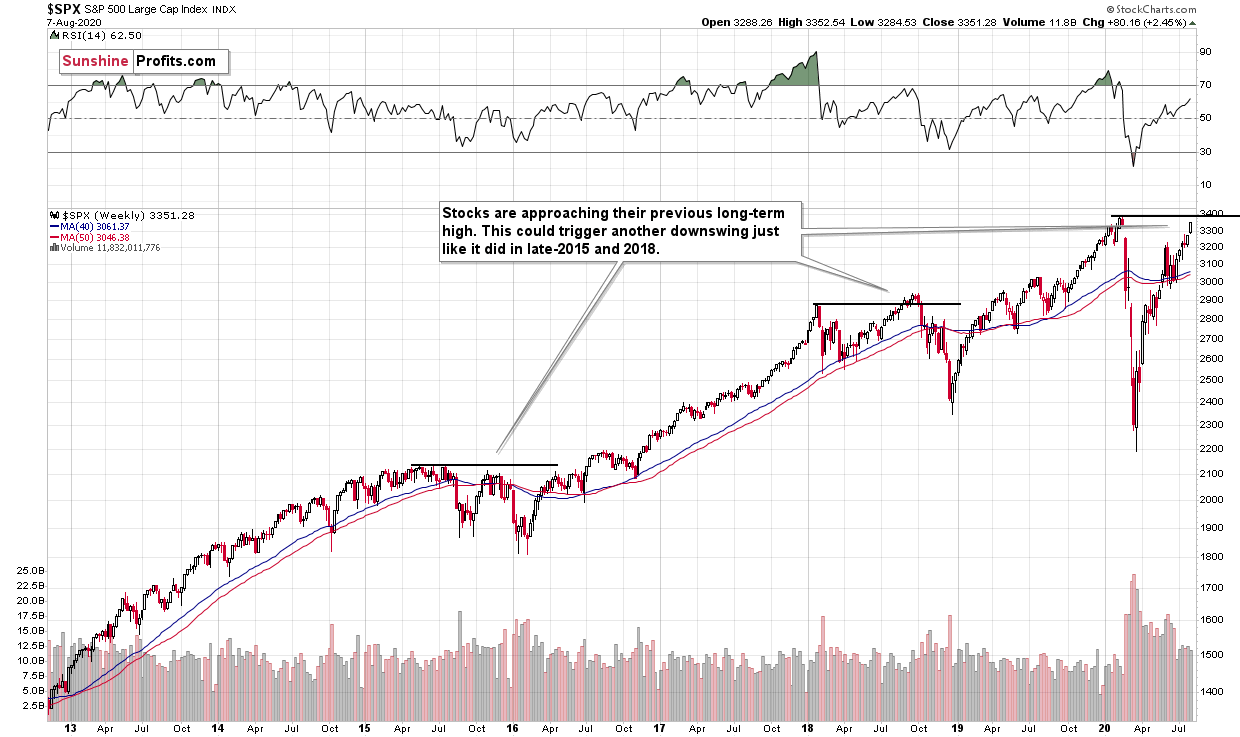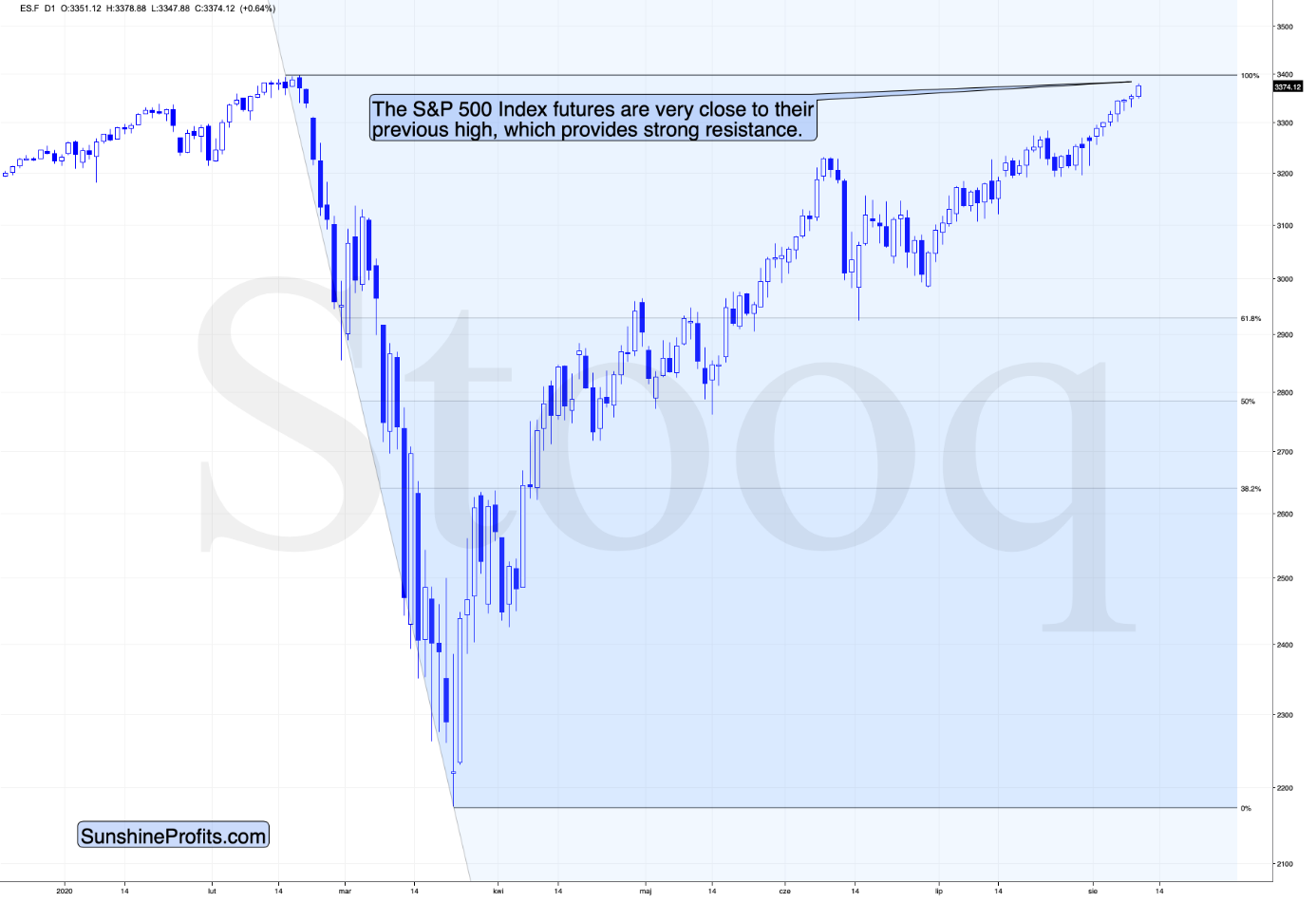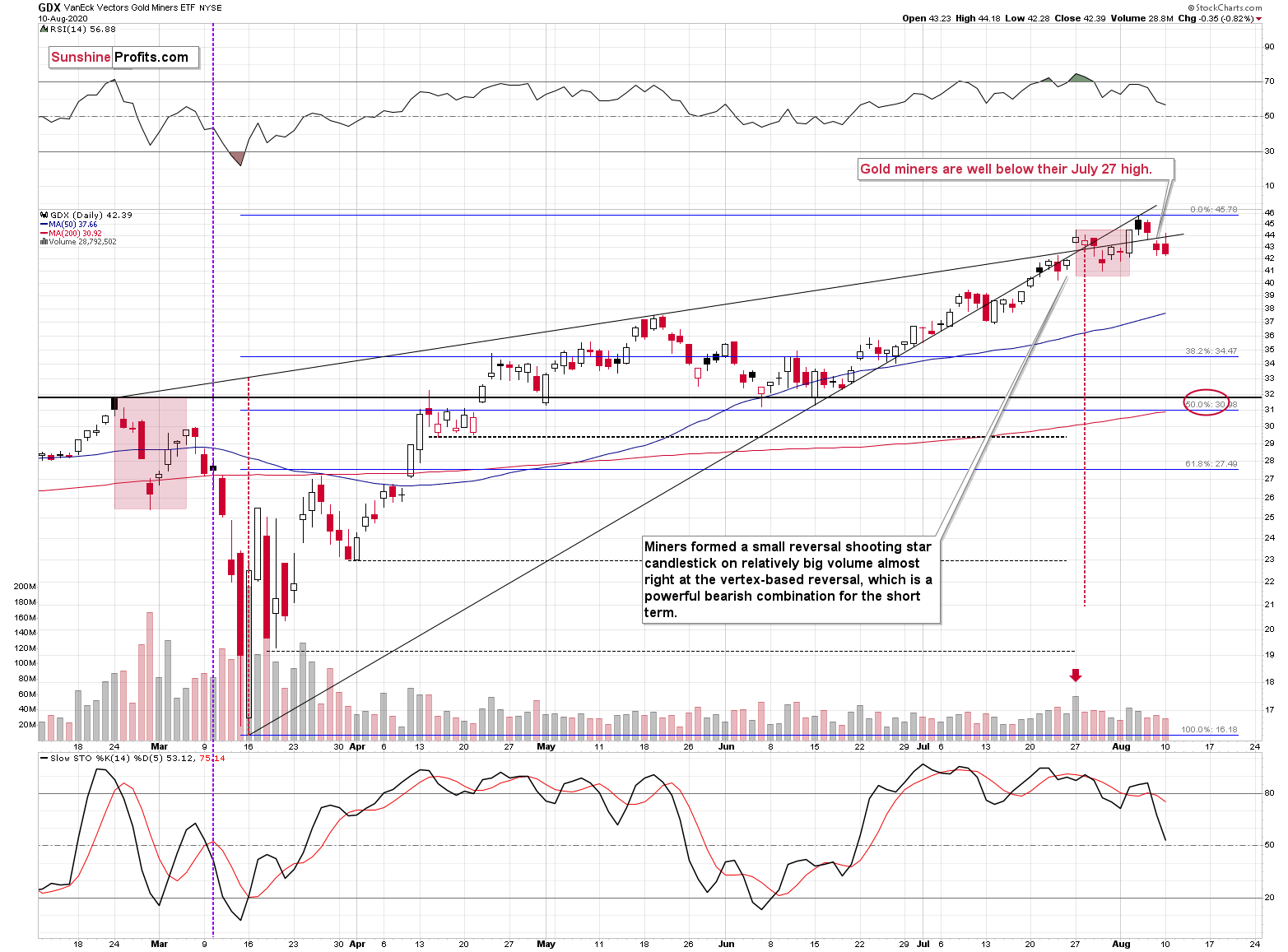Briefly: in our opinion, full (300% of the regular position size) speculative short positions in mining stocks are justified from the risk/reward point of view at the moment of publishing this Alert.
Gold declined quite visibly in today's pre-market trading (moving briefly below $2,000) and it happened right before miners' daily reversal. This seems to be a very bearish indication for the next several hours, and it might really be the case that the PMs will slide right away. However, we are still not ruling out a situation in which gold tests the previous highs once again, before finally topping.
Gold declined in a specific zig-zag pattern, which is a consolidation pattern. We saw something somewhat similar in late February. The initial decline was not THE decline yet. Gold first tested the previous high and then topped in the most profound way. The thing that confirmed the top, was when gold failed to hold the breakout above the previous highs. Will we see something like that once again?
It's unclear at this time. The shape of the decline so far makes both outcomes possible.
The USD Index seems to have formed a double-bottom pattern, but... We still can't rule out a scenario in which the double-bottom pattern would turn into a triple-bottom pattern. The USDX just reversed and declined a bit, and gold reacted with another rally. So, it seems that if the USD Index continues to trade sideways, gold will do the same thing.
After all, most of the bottoms in the USD Index that formed mid-year (marked with purple ellipses) were rather broad, so we wouldn't rule out something similar also this time.
Then again, gold is very overbought in the short run (and so is silver and the rest of the precious metals sector), so it's likely to be vulnerable to a meaningful show of strength in the USDX.
Will the latter finally rally soon? This seems likely based on the invalidation of the breakdown below the rising long-term support line, but a rally without another move closer to the recent lows is far from being a sure bet.
Gold is not likely to form a broad top here, as it's not the kind of performance that gold exhibited after similarly sharp rallies in the past - in 2006, 2008, 2009/2010, and 2011. Interestingly, all the above-mentioned spike tops formed close to gold's long-term cyclical turning point - which is also where gold is right now.
So, on one hand we could (but don't have to) have a broader bottom in the USD Index (which might indicate a broader top in gold), and on the other hand, we could have a spike-high in gold based on analogy to similar short-term rallies and long-term turning points. What's the most likely outcome here?
In my view, it would be most useful to look at gold's top that formed at the most similar price levels - the 2011 top.
There was an initial top in early August, then an initial top, and then - after several days - the final top. Gold's plunge was significant even after the first top. However, it was not significant after the initial early-August-2011 top.
The USD Index had been trading sideways, forming a broad bottom in 2011 and while the first decline in gold took place practically without USD's help, it was the decisive move higher in the USDX that really changed the picture.
Will the USD Index rally significantly from here? That's most likely in our view. But will this happen without an additional move to the previous lows? This is unclear.
Since markets don't move in isolation, we might get the final "go" signal from a different market. And this could be the stock market.
In yesterday's analysis, we wrote that all in all, gold is likely to rally far in the long run, but in the short run it's vulnerable to a sizable decline, when the economic implications of the pandemic's continuation become obvious to investors.
The S&P 500 is approaching its previous 2020 high. Given the economic background, I find this performance unfounded. But the markets can stick to a certain emotional trend for longer than many investors can remain logical, which would fit the above picture.
Back in 2015 stocks topped below their previous highs, and in 2018 they topped a bit above them, so the proximity to the previous is far from being a precise sell signal. It does indicate, that the stock market is likely vulnerable to sell signals coming from other markets and that this emotional rally could end sooner rather than later.
Do you remember what happened in February when the S&P 500 lost its upward momentum? They plunged, and that was when tops in mining stocks and silver formed. Gold made another attempt to move higher but ultimately declined profoundly in the following days.
As you can see on the above chart, the S&P 500 futures are already very close to the previous 2020 high. A move to this level, or - even better - a small breakout that is then invalidated, could be the perfect trigger for all above-mentioned moves. This could be what triggers a move higher in the USD Index, as investors turn to cash, which in turn could trigger a decline in gold, just like what we saw in 2011.
And if gold was to decline significantly here, then miners would be likely to truly plunge.
Miners have just formed a bearish daily reversal after a few weeks of underperformance relative to gold. This is a very bearish combination.
Still, if stocks are to move higher from here, and if gold reverses this week and then rallies, then miners could move higher one more time, before finally plunging. Today's session is likely to be a sign of weakness, but we might then see the final rally before the plunge - similarly to what we saw in late February and early March. It's not certain, but if it happens, please note that such an upswing would not change the overall strongly bearish outlook for the next few weeks.
Overview of the Upcoming Decline
As far as the current overview of the upcoming decline is concerned, I think that after bottoming temporarily at about $1,900, gold, silver and miners will bounce back - perhaps $30-$50 or so in gold, and then we will probably see another move lower, with silver declining more than miners. That would be in tune with how the markets initially reacted to the Covid-19 threat and how they performed after the previous long-term turning points.
At this time, it seems that after the initial decline to $1,900, gold could correct and then decline to about $1,700 and that would be the final bottom - one that would hold for years, perhaps decades.
Still, it's possible that the $1,900 bottom in gold would be the final bottom.
How will we tell, which scenario is more likely - a decline visibly below $1,900 or just to it? Based on the way different parts of the precious metals sector react to the decline and to the initial rebound. If silver catches up with the decline when gold moves to $1,900, but miners lead on the way back up (strongly so), it will be more likely that the bullish scenario prevails. If we see the opposite - miners are weak during the rebound and silver doesn't catch up with the decline once gold approaches $1,900, the bearish case will prevail. Anything in between will require additional confirmations and we will keep you - our subscribers - updated in any case.
The impact of all the new rounds of money printing in the U.S. and Europe on the precious metals prices is very positive in the long run, but it doesn't make the short-term decline unlikely. In the very near term, markets can and do get ahead of themselves and then need to decline - sometimes very profoundly - before continuing their upward march.
Summary
Summing up, it seems that after reversing $4 above our upside target, gold has finally topped. The opposite appears likely in store for the USD Index, which seems to have formed a double-bottom pattern. While we can't rule out a situation in which the PMs and miners move higher one final time before plunging, it seems that regardless of this move, the outlook for the next few weeks for the mining stocks is very bearish.
Naturally, everyone's trading is their responsibility, but in our opinion, if there ever was a time to either enter a short position in the miners or to increase its size if it wasn't already sizable, it's now. We made money on the March decline and on the March rebound, and it seems that another massive slide is about to start. When everyone is on one side of the boat, it's a good idea to be on the other side, and the Gold Miners Bullish Percent Index literally indicates that this is the case with mining stocks.
After the sell-off (that takes gold to about $1,700), we expect the precious metals to rally significantly. The final decline might take as little as 1-6 weeks, so it's important to stay alert to any changes.
Most importantly - stay healthy and safe. We made a lot of money on the March decline and the subsequent rebound (its initial part) price moves (and we'll likely make much more in the following weeks and months), but you have to be healthy to really enjoy the results.
As always, we'll keep you - our subscribers - informed.
To summarize:
Trading capital (supplementary part of the portfolio; our opinion): Full speculative short positions (300% of the full position) in mining stocks is justified from the risk to reward point of view with the following binding exit profit-take price levels:
Senior mining stocks (price levels for the GDX ETF): binding profit-take exit price: $32.02; stop-loss: none (the volatility is too big to justify a SL order in case of this particular trade); binding profit-take level for the DUST ETF: $28.73; stop-loss for the DUST ETF: none (the volatility is too big to justify a SL order in case of this particular trade)
Junior mining stocks (price levels for the GDXJ ETF): binding profit-take exit price: $42.72; stop-loss: none (the volatility is too big to justify a SL order in case of this particular trade); binding profit-take level for the JDST ETF: $21.22; stop-loss for the JDST ETF: none (the volatility is too big to justify a SL order in case of this particular trade)
For-your-information targets (our opinion; we continue to think that mining stocks are the preferred way of taking advantage of the upcoming price move, but if for whatever reason one wants / has to use silver or gold for this trade, we are providing the details anyway. In our view, silver has greater potential than gold does):
Silver futures downside profit-take exit price: unclear at this time - initially, it might be a good idea to exit, when gold moves to $1,703.
Gold futures downside profit-take exit price: $1,703
Long-term capital (core part of the portfolio; our opinion): No positions (in other words: cash
Insurance capital (core part of the portfolio; our opinion): Full position
Whether you already subscribed or not, we encourage you to find out how to make the most of our alerts and read our replies to the most common alert-and-gold-trading-related-questions.
Please note that the in the trading section we describe the situation for the day that the alert is posted. In other words, it we are writing about a speculative position, it means that it is up-to-date on the day it was posted. We are also featuring the initial target prices, so that you can decide whether keeping a position on a given day is something that is in tune with your approach (some moves are too small for medium-term traders and some might appear too big for day-traders).
Plus, you might want to read why our stop-loss orders are usually relatively far from the current price.
Please note that a full position doesn't mean using all of the capital for a given trade. You will find details on our thoughts on gold portfolio structuring in the Key Insights section on our website.
As a reminder - "initial target price" means exactly that - an "initial" one, it's not a price level at which we suggest closing positions. If this becomes the case (like it did in the previous trade) we will refer to these levels as levels of exit orders (exactly as we've done previously). Stop-loss levels, however, are naturally not "initial", but something that, in our opinion, might be entered as an order.
Since it is impossible to synchronize target prices and stop-loss levels for all the ETFs and ETNs with the main markets that we provide these levels for (gold, silver and mining stocks - the GDX ETF), the stop-loss levels and target prices for other ETNs and ETF (among other: UGLD, DGLD, USLV, DSLV, NUGT, DUST, JNUG, JDST) are provided as supplementary, and not as "final". This means that if a stop-loss or a target level is reached for any of the "additional instruments" (DGLD for instance), but not for the "main instrument" (gold in this case), we will view positions in both gold and DGLD as still open and the stop-loss for DGLD would have to be moved lower. On the other hand, if gold moves to a stop-loss level but DGLD doesn't, then we will view both positions (in gold and DGLD) as closed. In other words, since it's not possible to be 100% certain that each related instrument moves to a given level when the underlying instrument does, we can't provide levels that would be binding. The levels that we do provide are our best estimate of the levels that will correspond to the levels in the underlying assets, but it will be the underlying assets that one will need to focus on regarding the signs pointing to closing a given position or keeping it open. We might adjust the levels in the "additional instruments" without adjusting the levels in the "main instruments", which will simply mean that we have improved our estimation of these levels, not that we changed our outlook on the markets. We are already working on a tool that would update these levels on a daily basis for the most popular ETFs, ETNs and individual mining stocks.
Our preferred ways to invest in and to trade gold along with the reasoning can be found in the how to buy gold section. Additionally, our preferred ETFs and ETNs can be found in our Gold & Silver ETF Ranking.
As a reminder, Gold & Silver Trading Alerts are posted before or on each trading day (we usually post them before the opening bell, but we don't promise doing that each day). If there's anything urgent, we will send you an additional small alert before posting the main one.
Thank you.
Sincerely,
Przemyslaw Radomski, CFA
Editor-in-chief, Gold & Silver Fund Manager


